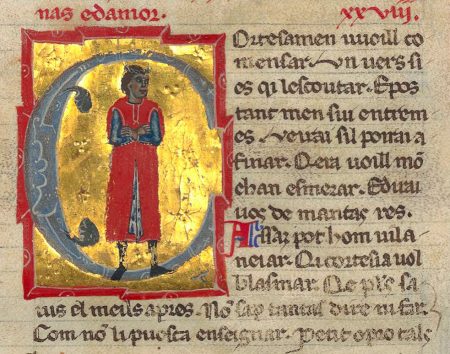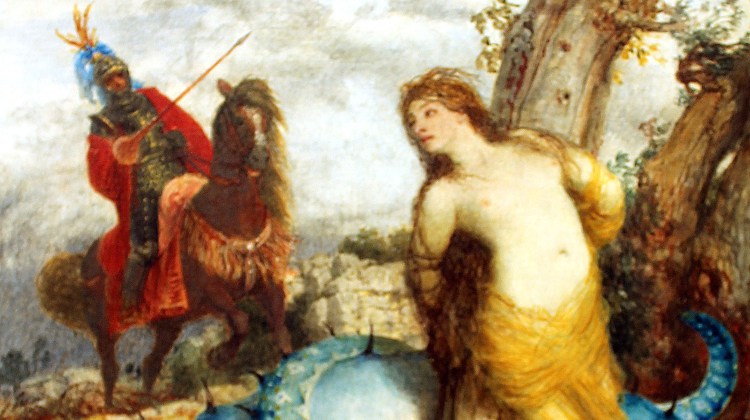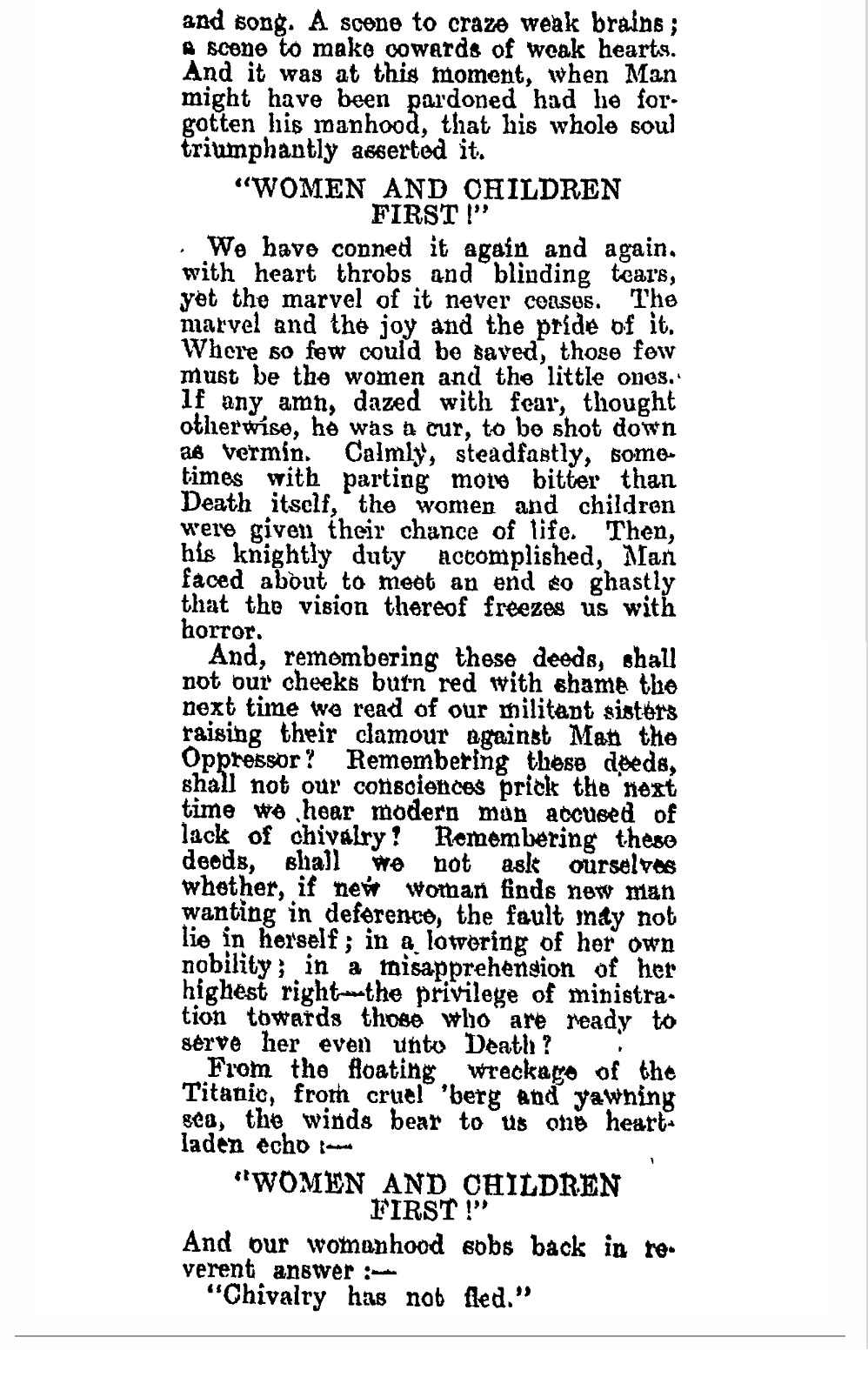By Douglas Galbi
Charles Darwin’s seminal 1871 book, The Descent of Man, and Selection in Relation to Sex, pushed down men’s sexual status along with much subsequent, poor-quality academic work on sexual selection. Yet men’s sexual status descended even more significantly in medieval Europe through the love teaching in the Latin work Facetus: Moribus et vita {Courtly living: manners and life}. The miseducation of men about love and sex provides a sobering case study in the need to question authority and undertake independent thinking and probing.

Disseminated across Europe from about the middle of the twelfth century, Facetus: Moribus et vita imitates Ovid’s Ars Amatoria {The Craft of Loving}. Yet while Ovid offered considerable roguish wisdom for men in love, Facetus: Moribus et vita promotes the men-abasing, counter-productive cult of courtly love. For example, it advises men to address their beloved with extravagant praise:
Bright, radiant star, lovely, gracious of countenance,
look here — permit your servant to speak with you now.
If your nobility, virtue, and beauty are
praised properly, you are without peer.
You surpass all girls in shapely beauty
and would conquer Venus, were she not a goddess.
Your hair is golden, your forehead is high and rightly so,
your eyes are laughing, your brows gorgeous.
{ Stella serena micans, facie rutilante decora,
ecce tuum famulum nunc patiare loqui.
Si tua nobilitas, probitas vel forma decora
laudatur velut est, par tibi nulla manet;
tu superas cunctas forma praestante puellas
et vincis Venerem, ni foret illa dea.
Aurea cesaries tibi, frons est, ut decet, alta,
ridentes oculi, pulchra supercilia. } [1]
Wrong, wrong, wrong. Those words just encourages the girl to feel superior to you, if she actually believes such all-too-common nonsense. According to a late-twelfth-century troubadour lyric, an upper-class man seeking sex with a peasant girl tried such lines on her. He received poor but fitting payment from her:
“Sir, you have praised me so much
that I’ve gotten bored.
Since you have extolled my virtue,
Lord,” said the peasant girl,
“you’ll have this wage
when you leave: ‘Beware, fool, beware!’
and having wasted the afternoon.”
{ Seigner, tan m’avetz lauzada,
Que tota·n sui enojada!
Pois en pretz m’avetz levada,
Seigner, so·m dis la vilana,
Per so n’auretz per soudada
Al partir : bada, fols, bada,
E la muz’a meliana. } [2]
Facetus: Moribus et vita goes on to advise the man to act pathetic and to proclaim his willingness to have his beloved rule over him:
When I do not see you, I desire to see and perish —
I die foolishly, for love burns me excessively.
Already I am your domestic servant. To you I deliver myself, if that pleases you,
so that I can do always what you alone command to me.
If you should look upon me or deign to love me,
I would rejoice more than if kingdoms were given to me.
I pray only for this: that you acknowledge your loving domestic servant,
so that he may live through you, my life and my health.
{ Cum te non video, pereo cupioque videre,
insipiens morior, nam nimis urit amor.
Iam tibi sum famulus; tibi, si placet, exibeo me
ut semper faciam quod michi sola jubes.
Si me conspicias vel me dignaris amare,
gaudebo plus quam si mihi regna darent.
Deprecor hoc tantum: famulum fatearis amandum
ut per te vivat, vita salusque mea. }
Men relating to their wives in this way has increased the incidence of sexless marriage and divorce. Of course most women are happy to acquire a domestic servant. But fawning, weak-willed domestic servants don’t stimulate most women’s passion. Men who believe otherwise are learned fools.
Facetus: Moribus et vita even advises men to commit a serious crime in order to please women. Almost all men, like almost all male primates, won’t use force to compel women to have sex with them. Rape of women has been regarded as a serious crime throughout history, and most men are not rapists. Seeking to pervert men’s natural respect for women, Facetus: Moribus et vita declares:
Then let them not merely join sweet lips;
let them dally in long, passionate embraces.
Meanwhile, let one roving hand grasp her breast,
and let him feel her thigh and belly in turn.
After such play both will be aroused,
and having thrown off their clothes, he should lift her legs.
Let the boy use force, even if she fights back,
for if he should stop, the girl would grieve in her mind.
A woman expects to be conquered in the wrestling, rather than
wants to endure, like a whore, the crime willingly.
Only in brothels are they commonly soliciting sex,
those who for a price sell themselves to anyone.
He who desires sex, but refrains from using force after kisses,
is a simpleton, never worthy of greater loving.
{ Tunc non simpliciter jungantur grata labella,
sed teneant longas basia pressa moras.
Mobilis interea stringat manus una mamillas.
Et femur et venter sentiat inde vicem.
Sic postquam ludens fuerit calefactus uterque,
vestibus ejectis, crura levare decet.
Vim faciat juvenis, quamvis nimis illa repugnet,
nam si desistat, mente puella dolet.
Expectat potius luctando femina vinci
quam velit, ut meretrix, crimina sponte pati.
A ganeis tantum coitus solet esse petitus,
que se pro precio vendere cuique volunt.
Qui querit coitum, si vim post oscula differt,
Rusticus est, nunquam dignus amore magis. }
This advice upholds the pattern, prevalent throughout human history, of making men responsible for an act considered to be criminal. Men, merely by virtue of their human dignity, are entitled to a life that includes loving, consensual, enthusiastic sex. Men should not be required to rape women in order to please women. Instructing men to undertake a criminal act in order to please women promotes the huge gender protrusion among persons held in prisons.
Frustration and anger are the primary effect of literature encouraging men to abase and criminalize themselves in seeking love with women. Because men are generally unwilling to rape women, rape of men is about as prevalent as rape of women despite miseducation of men. Many men taught that they must rape women in order to have sex with women will instead simply not have sex with women. In their miseducation and ignorance, these men will become frustrated and angry. Such frustration and anger is apparent in some late twelfth-century troubadour lyrics:
Three pass before me up the passage-way.
Before I know where I am the fourth fucks her and the fifth comes running up.
Thus love declines and gets worse.
These cunts are lusty and rapacious.
All these ruffians claim a share in them, and they in the ruffians,
and the man who behaves best fares worst, as do shepherds with lambs.
{ Denan mei n’i passson trei al passador;
no·n sai mot tro·l quartz la fot, e·l quinze lai cor;
enaissi torn’a decli l’amors e torna en peior.
Aquist con son deziron e raubador;
tuit cill gartz i clamon partz et ill en lor:
e qui mieills fa, sordeitz a, cum de l’agol’ an pastur. } [3]
A society that cared for its men would provide a minimal level of sexual welfare for men. Instead, men in the U.S. are forced to pay monthly “child support” to women who have raped them. The lesson is obvious: question authority, think independently, and explore how life actually works.
* * * * *
Notes:
[1] Facetus: Moribus et vita {Courtly living: Manners and life} 209-16, Latin text from Cantavella (2013) pp. 273-87, English translation adapted from Elliott (1977) to follow the Latin more closely. Morel-Fatio (1886) provides Elliott’s Latin text. Cantavella’s Latin text incorporates small variants from a Barcelonian manuscript dated to the twelfth or thirteenth century. Cantavella’s study primarily concerns a Catalan adaptation made in the first half of the fourteenth century.
The second part of the conventional title Facetus: Moribus et vita comes from its first line, Moribus et vita quisque vult esse facetus {Whoever wishes to be courtly in manners and life}. Another, different twelfth-century Facetus poem begins Cum nichil utilius humane credo saluti {Since I believe that nothing is more beneficial to human welfare}. The latter Facetus poem, not the former, became part of the Auctores octo.
Facetus: Moribus et vita is thought to have been written in the mid-twelfth century. In some manuscripts it’s attributed to the poet Aurgena. Id. p. 27. At least thirty manuscripts of it have survived. The section on instruction to men in love also circulated independently. It has survived in whole or in part in at least twenty-five manuscripts. Dronke (1976) pp. 126, 128.
The subsequent two quotes from Facetus: Moribus et vita are sourced as the quote above. They are (cited by Latin line numbers) 235-42 (When I do not see you…) and 289-302 (Then let them…).
[2] Marcabru, song 30, L’autrier jost’ una sebissa {The other day, by a hedge}, stanza 8, from Old French trans. from trobar.org. Marcabru florished between 1129 and 1150.
[3] Marcabru, song 24, En abriu, s’esclairo·il riu contra·l Pascor {In April, the streams become clear towards Easter}, stanzas 7-8, from Old French trans. Gaunt (2006) (stanza 7) and Kay, Cave & Bowie (2013) p. 36 (stanza 8). For a looser translation of the full poem, see trobar.org. Here’s the fully edited, Old French text. Gaunt provides a conventional, academic-gynocentric reading of the poem:
we should take this altogether typical misogynist and crude language in which women are spoken about as cunts, represented as whores with queues of men waiting to fuck them, and caricatured as only being interested in the size of a man’s penis, simply for what it is: Marcabru was steeped in the worst forms of clerical misogyny.
Gaunt (2006) p. 87. Like miseducating men, describing men as ruffians and reducing them to their penises harms men. More generally, engaging in misandristic labeling isn’t an enlightening scholarly enterprise. Literature like Facetus: Moribus et vita circulated far beyond clerics. Cantavella (2013). The corresponding, understandable frustration and anger of men undoubtedly also was widespread. Literature of men’s sexed protest provides a high return to serious, compassionate study.
[image] The troubadour Marcabru. Illumination from folio 102r in Chansonnier provençal (Chansonnier K) manuscript made in the second half of the 13th century. Preserved in Bibliothèque nationale de France as Français 12473. Via Gallica.
References:
Cantavella, Rosanna. 2013. El Facet, una ars amandi medieval: edició i estudi. València: Barcelona.
Dronke, Peter. 1976. “Pseudo-Ovid, Facetus, and the Arts of Love.” Mittellateinisches Jahrbuch (Stuttgart) 11: 126-131.
Elliott, Alison Goddard. 1977. “The Facetus: or, The Art of Courtly Living.” Allegorica. 2: 27–57.
Gaunt, Simon. 2006. “Obscene Hermeneutics in Troubadour Lyric.” Ch. 5 (pp. 85-104) in McDonald, Nicola, ed. Medieval obscenities. Woodbridge: York Medieval Press.
Kay, Sarah, Terence Cave, and Malcolm Bowie. 2003. A short history of French literature. Oxford: Oxford University Press.
Morel-Fatio, Alfred. 1886. “Mélanges de littérature catalane.” Romania. 15 (58): 192-235.











